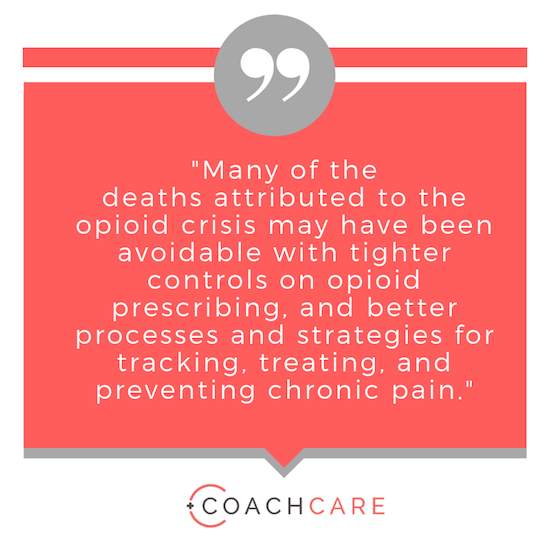Innovations in Digital Health Technology Could Combat the Opioid Crisis
Opioid overdoses were responsible for over 72,000 deaths in the U.S. in 2017 and more than 2,800 deaths in Canada. While awareness of the opioid crisis has increased, lives are still being lost every day. Now, public health researchers and pain management specialists are increasingly looking to digital health technologies and coaching software to help turn the tide.

Many of the deaths attributed to the opioid crisis may have been avoidable with tighter controls on opioid prescribing, and better processes and strategies for tracking, treating, and preventing chronic pain. Opioids remain the most effective drugs for acute pain relief, but they were never intended for use in managing chronic pain, and chronic pain conditions are on the rise – in part thanks to our aging population.
Opioid Prescribing – How Digital Health Technology Can Help
Migraines, arthritis, and other common conditions can cause debilitating pain, and some patients are being prescribed opioids for these conditions far in excess of recommended guidelines. By using digital health coaching software to track patient prescriptions and medication use, clinicians are better placed to make informed decisions when prescribing drugs and treatments.
This may simply mean ensuring a ‘stay low, go slow’ mentality through in-built alerts that keep a check on increased dosages or repeat prescriptions for acute conditions. Digital record keeping may also help a clinician see if a client has recently filled a prescription for opioids from another doctor or clinic.
According to Specialty Pharmacy Times, a person’s risk of developing opioid use disorder within a year rises significantly with the size of their very first prescription: from a 10% risk with a 5-day supply to a staggering 45% risk with a 30-day supply. Clinicians prescribing opioids need to consider, therefore, whether the potential benefits of acute pain relief outweigh the risks of misuse, disorder, and dependence. If a clinician does prescribe opioids, a short course is recommended, with close monitoring of the client.
Monitoring Opioid Use and Pain Symptoms
Digital health technology offers a variety of ways to make monitoring more robust, effective, and less time consuming for both the client and clinician. For example, patients can easily track symptoms via a patient portal, and clinicians can see in real-time how their clients are responding to treatment. And by automatically tracking opioid use and the clients’ reports of pain and other symptoms, digital health software can alert a clinician to potential problems that may be missed or only identified much later without such software.
Digital health technologies can also help clinicians gain improved insight into their clients’ health habits through coaching software to better inform decision making around opioid prescription.
Improved Access to Information For Patients
Patients themselves are better placed to make informed decisions about their health needs when they have easy access to resources about pain management. Patient portals are great way to improve client education, offering easy access to information on the risks of opioid use and alternative pain management strategies.
By helping clients with chronic pain to access information about how to manage pain more effectively, a patient portal helps reduce the likelihood of painkiller misuse. A comprehensive digital health system might, for instance, promote free resources about mindfulness, yoga, and other stress management and pain relief strategies whenever a client reports a spike in pain symptoms.
Clinics can also use digital health systems to automatically schedule follow-up appointments, thereby ensuring that a client who seems to be struggling is seen quickly by their clinician.
Digital Innovation to Save Lives
On a different level, digital health technology can help support the safety and integrity of the opioid medication supply chain, reducing the risk of drug diversion, while helping to maintain the availability of medications for those who need them.
The U.S. Department of Health and Human Services even held a code-a-thon in late 2017 to invite innovators from across the U.S. to contribute ideas on how to use digital technology to combat the opioid crisis (R). Entrants could compete for one of three $10,000 prizes and more than 50 teams entered, with projects fitting into three categories: prevention track coding; treatment track coding; and usage track coders.
Coders who entered the competition created tools that identified and reported illicit online pharmacies, predicted opioid overdose outbreaks, and tracked overdoses in real-time (allowing first responders and health authorities to prepare better and save more lives). One of the winners designed an Opioid Prescriber Awareness Tool, which allows physicians to compare their opioid prescribing habits to those of their peers. While this tool is not yet available, clinicians can already use some digital health systems to see the prescribing habits of the physicians in their clinic. This could help flag possible overprescribing and help clinics better support their staff and clients to minimize the risk of opioid dependence.
About CoachCare:
CoachCare powers clinics with a virtual health and remote patient monitoring platform that reflects your unique workflow and protocol. Remote patient monitoring insurance features drive significant additional revenue while lowering the overall cost of care. Contact us to learn more.